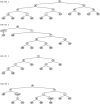Lung cancer prediction from microarray data by gene expression programming
- PMID: 27762231
- PMCID: PMC8687242
- DOI: 10.1049/iet-syb.2015.0082
Lung cancer prediction from microarray data by gene expression programming
Abstract
Lung cancer is a leading cause of cancer-related death worldwide. The early diagnosis of cancer has demonstrated to be greatly helpful for curing the disease effectively. Microarray technology provides a promising approach of exploiting gene profiles for cancer diagnosis. In this study, the authors propose a gene expression programming (GEP)-based model to predict lung cancer from microarray data. The authors use two gene selection methods to extract the significant lung cancer related genes, and accordingly propose different GEP-based prediction models. Prediction performance evaluations and comparisons between the authors' GEP models and three representative machine learning methods, support vector machine, multi-layer perceptron and radial basis function neural network, were conducted thoroughly on real microarray lung cancer datasets. Reliability was assessed by the cross-data set validation. The experimental results show that the GEP model using fewer feature genes outperformed other models in terms of accuracy, sensitivity, specificity and area under the receiver operating characteristic curve. It is concluded that GEP model is a better solution to lung cancer prediction problems.
Figures








Similar articles
-
Prediction of NSCLC recurrence from microarray data with GEP.IET Syst Biol. 2017 Jun;11(3):77-85. doi: 10.1049/iet-syb.2016.0033. IET Syst Biol. 2017. PMID: 28518058 Free PMC article.
-
A Highly Efficient Gene Expression Programming (GEP) Model for Auxiliary Diagnosis of Small Cell Lung Cancer.PLoS One. 2015 May 21;10(5):e0125517. doi: 10.1371/journal.pone.0125517. eCollection 2015. PLoS One. 2015. PMID: 25996920 Free PMC article.
-
Prediction of lung cancer based on serum biomarkers by gene expression programming methods.Asian Pac J Cancer Prev. 2014;15(21):9367-73. doi: 10.7314/apjcp.2014.15.21.9367. Asian Pac J Cancer Prev. 2014. PMID: 25422226
-
Network-based drug sensitivity prediction.BMC Med Genomics. 2020 Dec 28;13(Suppl 11):193. doi: 10.1186/s12920-020-00829-3. BMC Med Genomics. 2020. PMID: 33371891 Free PMC article.
-
Circulating microRNA-422a is associated with lymphatic metastasis in lung cancer.Oncotarget. 2017 Jun 27;8(26):42173-42188. doi: 10.18632/oncotarget.15025. Oncotarget. 2017. PMID: 28178679 Free PMC article. Review.
Cited by
-
Chaotic emperor penguin optimised extreme learning machine for microarray cancer classification.IET Syst Biol. 2020 Apr;14(2):85-95. doi: 10.1049/iet-syb.2019.0028. IET Syst Biol. 2020. PMID: 32196467 Free PMC article.
-
A Holistic Performance Comparison for Lung Cancer Classification Using Swarm Intelligence Techniques.J Healthc Eng. 2021 Jul 29;2021:6680424. doi: 10.1155/2021/6680424. eCollection 2021. J Healthc Eng. 2021. PMID: 34373776 Free PMC article.
-
Lung cancer diagnosis based on weighted convolutional neural network using gene data expression.Sci Rep. 2024 Feb 13;14(1):3656. doi: 10.1038/s41598-024-54124-7. Sci Rep. 2024. PMID: 38351141 Free PMC article.
-
A novel gene selection algorithm for cancer classification using microarray datasets.BMC Med Genomics. 2019 Jan 15;12(1):10. doi: 10.1186/s12920-018-0447-6. BMC Med Genomics. 2019. PMID: 30646919 Free PMC article.
-
Differentially Expressed Gene Screening, Biological Function Enrichment, and Correlation with Prognosis in Non-Small Cell Lung Cancer.Med Sci Monit. 2019 Jun 10;25:4333-4341. doi: 10.12659/MSM.916962. Med Sci Monit. 2019. PMID: 31181055 Free PMC article.
References
-
- Engchuan W., and Chan J.H.: ‘Pathway activity transformation for multi‐class classification of lung cancer datasets’, Neurocomputing, 2015, 165, pp. 81–89 (doi: 10.1016/j.neucom.2014.08.096) - DOI
-
- Society A.C.: ‘Cancer facts & figures 2011’ (American Cancer Society Inc., 2011), vol. 1
-
- Laureen W., and Goh B.C.: ‘An overview of cancer trends in Asia’ (Innovationmagazine.com., 2012)
-
- Spitz M.R. Wei Q., and Dong Q. et al.: ‘Genetic susceptibility to lung cancer the role of DNA damage and repair’, Cancer Epidemiol. Biomarkers Prev., 2003, 12, pp. 689–698 - PubMed
MeSH terms
Substances
LinkOut - more resources
Full Text Sources
Other Literature Sources
Medical

